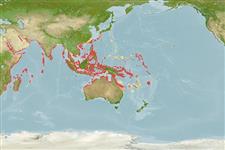Common names from other countries
Environment: milieu / climate zone / depth range / distribution range
Ecología
Asociado a arrecife; rango de profundidad 0 - 10 m (Ref. 98471). Tropical; 31°N - 27°S, 32°E - 180°E (Ref. 847)
Distribución
Países | Áreas FAO | Ecosistemas | Ocurrencias, apariciones | Introducciones
Indo-West Pacific: Mozambique to Philippines, Micronesia and Fiji.
Length at first maturity / Tamaño / Peso / Age
Maturity: Lm ? range ? - ? cm
Found on shallow reef environments or sandy lagoons where colonies are often partly buried in sand (Ref. 847). Specifically found on sandy-scoured rocks and at the base of coral reefs (Ref. 102838). Found in environments with very high salinity and high temperature (Ref. 98471).
Life cycle and mating behavior
Madurez | Reproducción | Puesta | Huevos | Fecundidad | Larva
Members of the class Anthozoa are either gonochoric or hermaphroditic. Mature gametes are shed into the coelenteron and spawned through the mouth. Life cycle: The zygote develops into a planktonic planula larva. Metamorphosis begins with early morphogenesis of tentacles, septa and pharynx before larval settlement on the aboral end.
Veron, J.E.N. 2000. (Ref. 847)
IUCN Red List Status (Ref. 130435)
CITES status (Ref. 108899)
Not Evaluated
Human uses
| FishSource |
Herramientas
Más información
Age/SizeCrecimientoLength-weightLength-lengthMorfologíaLarvaAbundancia
Fuentes de Internet
Estimates based on models
Preferred temperature
(Ref.
115969): 25 - 29.3, mean 28.5 (based on 3163 cells).
Price category
Unknown.
